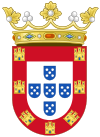Coat of arms of Ceuta
| Coat of arms of Ceuta | |
|---|---|

|
|
| Details | |
| Shield shape and division | Board |
| Heraldic shield | five quinas (coat of arms of Portugal) |
The Spanish exclave of Ceuta has had a coat of arms since the 15th century. It shows, surrounded by a red border with seven golden forts, the silver field with the five quinas placed crosswise . The golden crown rests on the coat of arms . The design goes back to the coat of arms of Portugal .
history
The coat of arms has been handed down historically. It dates from the time when the city was owned by the Portuguese crown after it was conquered by King John I on August 21, 1415. It remained the owner of Ceuta until 1580 and de jure until 1640. When, after the restoration of independence of Portugal remained the city in Spain in 1640 and 1668 as a result of the restoration of war in the Treaty of Lisbon was ceded permanently to Spain, the coat of arms remained.
The coat of arms of Portugal underwent two major modifications: The arrangement of the seven golden castles differs. The Portuguese coat of arms has a castle in the head of the shield instead of at the top. This is explained by the lower status of the city compared to cities closer to the king such as Lisbon. While the Portuguese coat of arms initially placed the king's crown on the edge of the shield and no longer has an attachment today, the coat of arms of Ceuta shows the crown of a marqué .
The coat of arms is placed on the changed service flag of Ceuta .
literature
- Karl-Heinz Hesmer: Flags and coats of arms of the world. History and symbolism of the flags and coats of arms of all states . Gütersloh: Bertelsmann Lexikon Verlag, 1992. ISBN 3-570-01082-1
Web links
- Flag lexicon (description of flag and coat of arms)
